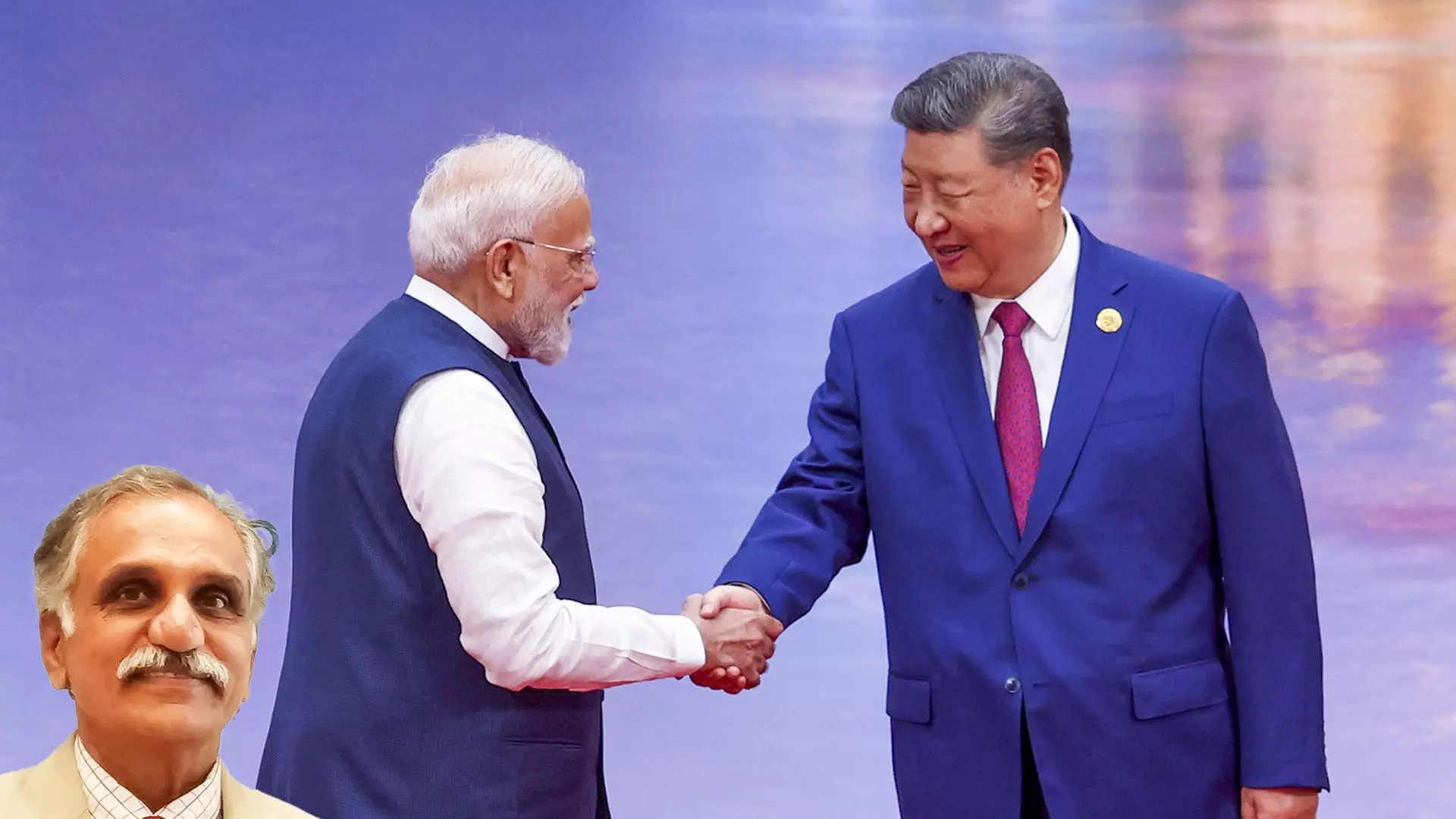
India-China at SCO: Retd Commodore Seshadri Vasan explains Modi’s balancing act
At the SCO Summit, PM Modi was tasked with mending frayed ties with China amid Trump’s steep tariffs; what was his strategy?

As India and China met on the sidelines of the Shanghai Cooperation Organisation (SCO) summit, New Delhi faced a complex triangle: a testy border, deep trade dependencies, and a changing global trade climate after the US imposed steep tariffs on Indian goods.
In this conversation, maritime strategist Commodore (Retd.) Seshadri Vasan, who is also associated with the Chennai Centre for China Studies, examined what this moment signalled for both countries and the region.
How significant was the Modi–Xi interaction at the SCO?
This meeting was watched closely because it was Prime Minister Modi’s first China visit after seven years. While some argued it was driven by US tariff pressure, there has been a separate, steady normalization since the October 23 meeting on the sidelines of Kazan. Signals that Modi would attend the SCO Summit were already visible, and high-profile engagements—including Chinese Foreign Minister Wang Yi’s visit—suggested that the momentum wasn’t primarily about tariffs. The deeper driver was a shared desire to reset ties strained since Galwan. The SCO provided a timely platform to do that.
Also read: Putin praises India's efforts for peace in Ukraine, slams West at SCO Summit
If tariffs weren’t the prime mover, what was?
This thaw is the product of patient processes: 25 rounds of border dialogue, track-two exchanges (including think-tank visits I was part of), and multiple official interactions. The idea is to identify correctable issues and reopen channels. That’s essential because China remains India’s largest trading partner and our trade deficit has persisted—even post-Galwan—reflecting critical dependencies in sectors where India relies heavily on Chinese inputs.
Beyond the optics, what concrete areas of convergence did you see at the SCO Summit?
First, a united stance on counter-terrorism. After Pahalgam, there’s broad recognition that such attacks are unacceptable and demand a collective response. Second, a push to think long-term about strategic relations. But the elephant in the room was the border. India prefers resolving the boundary first; China prefers “set aside the border, move ahead elsewhere”. That divergence remained.
Can the border question and Pakistan ties cap the relationship? How does India navigate that?
Pakistan will remain a factor. China has strong strategic stakes there, including the China–Pakistan Economic Corridor (CPEC)—which I refer to as the China–POK economic corridor to avoid implying legitimacy over territory India disputes. Beijing will want to safeguard heavy investments. At the same time, Washington drawing closer to Islamabad isn’t something China would welcome, and some recent US moves look aimed at cornering India. These are difficult times, but India isn’t abandoning the US; two-decade-old institutional mechanisms continue. Our focus at SCO is practical: new trade equations, more visas for Chinese technical staff, direct flights—positive signs, but tempered by caution until the border is addressed.
Also read: Modi, Putin, Xi's bonding steals spotlight at SCO; Pakistan's Shehbaz sidelined
So where exactly do the border talks stand?
China calls the boundary a colonial legacy and does not accept the McMahon Line, though it has settled other borders using similar principles elsewhere. Talks at military, political and diplomatic levels—about 25 rounds—have reduced immediate friction: buffer zones exist, and some disengagement has happened, notably around the lake area. Troops remain face-to-face and alert, but we’re not in a wartime posture. Historically, we shared a border with Tibet; only after Tibet’s occupation did China become our neighbour. Post-1962, there were ideas on trading Aksai Chin for quiet on what China calls “South Tibet” (Arunachal Pradesh), but those never fructified. Given public sensitivities over territory, I expect a “cold-shelved” boundary for 3–5 years: dialogue will continue, major breakthroughs are unlikely soon, and both sides will use this window to negotiate and manage.
China wants India in the Belt and Road Initiative. Does the current easing change New Delhi’s position?
No. India’s stance has been consistent: BRI contracts lack transparency and raise sovereignty concerns—especially given the corridor through Pakistan-occupied Kashmir. India skipped all three Belt and Road Forums. What can change is sector-specific investment: Chinese FDI may be allowed in carefully chosen areas with security vetting. Reports suggest openness up to minority stakes (even ~49 per cent) where appropriate. India needs capital and technology in some critical chains; China has surplus capacity and seeks markets. Well-designed, mutually agreed investments can fill gaps for India while giving China returns.
Also read: PM Modi flags concerns over cross-border terrorism in talks with Xi
If US-India ties quickly improve, does that undercut the India-China opening?
Not really. India practises strategic autonomy. We will align issue-by-issue in our national interest—sometimes with the US, sometimes with China, sometimes with Russia. Existing US frameworks remain active; new opportunities with China can proceed in parallel where they make sense. Beijing understands this. Even Chinese voices have noted that a blanket 50 per cent US tariff on Indian goods is illogical; regardless, India’s leadership is clear-eyed. The external affairs team is experienced, and policy will stay anchored in autonomy, growth to a top-three economy, and Atmanirbhar Bharat.
(The content above has been transcribed from video using a fine-tuned AI model. To ensure accuracy, quality, and editorial integrity, we employ a Human-In-The-Loop (HITL) process. While AI assists in creating the initial draft, our experienced editorial team carefully reviews, edits, and refines the content before publication. At The Federal, we combine the efficiency of AI with the expertise of human editors to deliver reliable and insightful journalism.)

